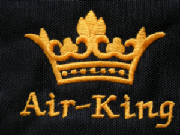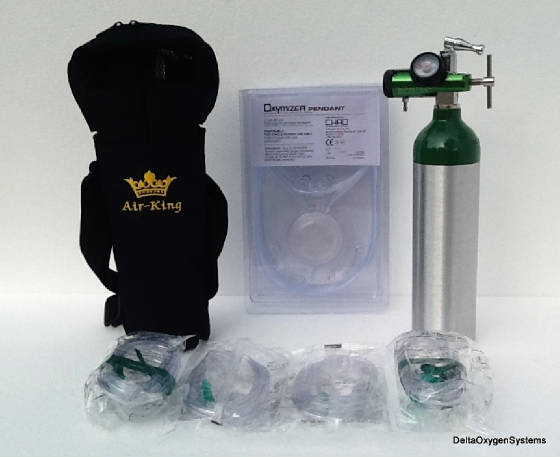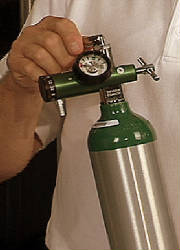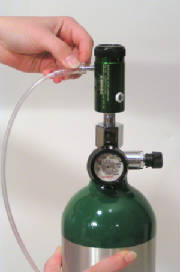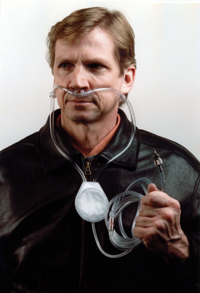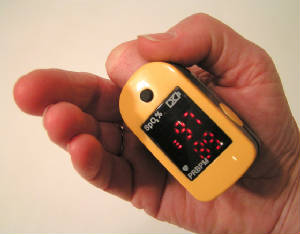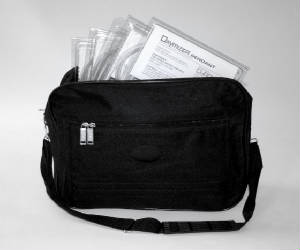|
|
Air-King™
Choosing a Portable Aviation Oxygen System for your Aircraft An aviation oxygen system is the primary safety component of an aircraft flying at high altitude to insure precious mental capabilities of the pilot for judgement and physical response. An aviation oxygen system will allow a pilot to make the most of a high performance aircraft by making use of favorable tail winds, flying above turbulence, conserving fuel, and enjoying lighter traffic between 10,000 and 20,000 ft. The FAA requires every pilot to use supplemental oxygen when flying above 12,500 ft. for more than 30 minutes, but supplemental oxygen can prevent the effects of hypoxia on a pilot at much lower altitudes. Experts recommend the use of supplemental oxygen for flying above 5,000 ft. at night and 8,000 ft. during the day to avert the effects of hypoxia. To read more about the effects of hypoxia and the benefits of supplemental aviation oxygen, please click this link: "Hypoxia, Oxygen and Pulse Oximetry" © Fred Furgang, MD. University of Miami School of Medicine. In his article, Dr. Furgang expains that "oxygen usage should be custom tailored to each individual pilot" who flies over 5,000 ft. He explains why some aviation oxygen system components fall short of providing the best safety features for preventing hypoxia. Delta Air-King portable systems deliver oxygen in liters per minute, an important safety feature. We also offer reasonably priced, excellent quality fingertip pulse oximeters to monitor blood oxygen levels - another important safety feature, according to Dr. Furgang.
The following are the main components of a portable aviation oxygen system: Oxygen tank: Aluminum cylinders are popular for their light weight and durability. The most popular sizes for portable aviation oxygen systems are 4, 6, 9, 15 and 24 cubic feet (113 to 680 liters.) Portable aviation oxygen tanks are typically 1 to 2 ft. tall and weigh 2 to 8 pounds. Care should always be taken not to bump or drop a cylinder or expose it to oil, dirt, dust or anything flammable. Our aluminum cylinders are strong yet lightweight,and produced from high strength aluminum alloy 6061-16. All seamless aluminum alloy compressed gas cylinders are manufactured in accordance with U.S. Department of Transportation (DOT) 3AL and Transport Canada (TC) 3ALM requirements. Every cylinder is inspected and tested by a DOT and TC authorized independent inspection agency. Manufacture date, PSI limit and cylinder number are all stamped on the cylinder shoulder. Hydrostatic testing of cylinders is required five years after the date stamped on cylinder. The amount of time the cylinder delivers oxygen before it needs to be refilled is the duration. Duration time depends on the size of the tank, how the oxygen is regulated and conserved, altitude, and other factors such as the age, sex and general health of the users. Oxygen conserving cannulas, or Oxymizers extend the duration time of a cylinder by up to four times over continuous flow oxygen delivery devices such as a standard oxygen mask or cannula. Oxymizers work by the utilization of a manifold in a reservoir that rests on the chest or in a "mustache-style" conserver. Oxymizers require no energy source or controls, are comfortable to wear, and provide about 500 hours of service life. Oxymizers are compatible with any Air-King aviation oxygen system.
Cylinder valve: Oxygen tanks come with two types of valves. A CGA 540 low profile valve (above, right) is popular for its compact size and ease of filling. A CGA 870 valve (above, left) with toggle allows for easy tool-free regulator mounting, one-hand turn on and off, and is popular because of the savings enjoyed when filling at compressed gas suppliers. We recommend carrying a CGA-870/540 yoke adapter for universal filling capability. Regulator: Regulators manage the flow of oxygen from the cylinder to the mask or cannula. The type of regulator is matched to the type of valve on the cylinder. For example, the CGA 870 valve and regulator have a pin-indexed system to assure the compatability between the tank and the regulator. Regulators are either fixed flow or variable flow. Our regulators are variable flow, either 0 to 8 LPM or 0 to 15 LPM depending on individual requirements. An important feature for an aviation system is an adjustable flow regulator. A typical range of flow for an aviation system would be zero to 15 or 24 liters per minute (or LPM). A constant flow regulator emits the same amount of oxygen regardless of need, which is not effective in an aviation situation. Adjustable flow regulators allow a pilot to adjust the regulator setting for changing conditions such as altitude and number of people using the oxygen system. Gauge: Most regulators have a gauge to indicate the fill level of the tank. The CGA 540 low profile valve has a gauge on the valve itself to indicate pressure with or without the regulator on the valve. A cylinder with a CGA 870 valve has a gauge on the regulator.
Oxygen delivery devices: Standard oxygen masks, nasal cannulas and non-rebreather masks are all options with an aviation oxygen system. Disposable standard masks and cannulas are an economical means of oxygen delivery if system users change frequently or extended tank duration is not an issue. Oxygen conserving devices called "Oxymizers" are a great alternative to standard masks and cannulas and allow for duration times to be increased up to 75% over standard masks and cannulas. They are available in the convenient "pendant" style or the original "mustache" style. Most pilots prefer the pendant style for comfort. Oxymizers may be used up to 18,000 ft. Above 18,000 ft, standard oxygen masks must be used, and over 25,000 ft., non-rebreather masks are required, according to the FAA. For a detailed description, please see the "Oxymizers" page found on the Navigation Bar.
Carrying Cases: Choose from many different types of carrying cases - accessory bags, shoulder bags, seat bags and convertible "fanny pack" bags. We also offer a number of hard, lockable, water resistant cases which offer excellent protection for the system while traveling or in storage. Our paded shoulder bags are heavy-duty black nylon with our embroidered golden yellow Air-King crown logo for a great look. Pilot gear bag, seen at right, is the perfect size to carry all of your oxygen system accessories. Seat bags hold the 15 and 24 cu.ft. cylinders securelyin place behind a seat. |
|||||||||||||||||||||||||||||||||||||||||||||||||||||||||||||||||||||||

